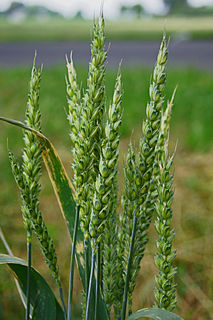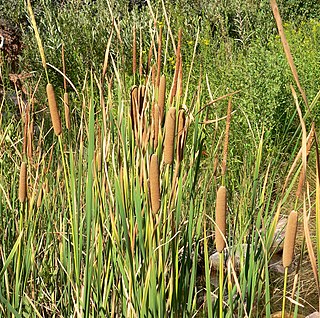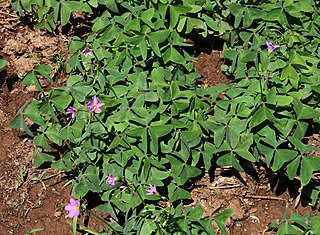
The Poales are a large order of flowering plants in the monocotyledons, and includes families of plants such as the grasses, bromeliads, and sedges. Sixteen plant families are currently recognized by botanists to be part of Poales.

Typha is a genus of about 30 species of monocotyledonous flowering plants in the family Typhaceae. These plants have a variety of common names, in British English as bulrush or reedmace, in American English as reed, cattail, or punks, in Australia as cumbungi or bulrush, in Canada as cattail, and in New Zealand as raupo. Other taxa of plants may be known as bulrush, including some sedges in Scirpus and related genera.

In botany, a spadix is a type of spike inflorescence having small flowers borne on a fleshy stem. Spadices are typical of the family Araceae, the arums or aroids. The spadix is typically surrounded by a leaf-like curved bract known as a spathe. For example, the "flower" of the well known Anthurium spp. is a typical spadix with a large colorful spathe.

Typha latifolia is a perennial herbaceous plant in the genus Typha. It is found as a native plant species in North and South America, Europe, Eurasia, and Africa. In Canada, broadleaf cattail occurs in all provinces and also in the Yukon and Northwest Territories, and in the United States, it is native to all states except Hawaii. It is an introduced and invasive species, and is considered a noxious weed, in Australia and Hawaii. It has been reported in Indonesia, Malaysia, New Zealand, Papua New Guinea, and the Philippines.

Sagittaria latifolia is a plant found in shallow wetlands and is sometimes known as broadleaf arrowhead, duck-potato, Indian potato, or wapato. This plant produces edible tubers that have traditionally been extensively used by the indigenous peoples of the Americas.

Street Heath is a 12.5 hectare biological Site of Special Scientific Interest 4 km west of Glastonbury in Somerset, notified in 1966. It next to the Glastonbury Canal and Ham Wall nature reserve. Street Heath has itself been designated as a Local Nature Reserve.

Typha angustifolia L. is a perennial herbaceous plant of genus Typha. This cattail is an "obligate wetland" species that is commonly found in the northern hemisphere in brackish locations.

The Giardino Botanico Alpinia is a botanical garden specializing in alpine plants, located at 800 m altitude above Stresa on Lake Maggiore, Province of Verbano-Cusio-Ossola, Piedmont, Italy. It can be reached via the Lido di Carciano - Alpino - Mottarone cable car, and is open daily in the warmer months.

Calamotropha paludella is a species of moth of the family Crambidae. It is found in Europe, Africa, Australia and large parts of Asia.

Typha domingensis, known commonly as southern cattail or cumbungi, is a perennial herbaceous plant of the genus Typha.

Oxalis latifolia is a species of flowering plant in the woodsorrel family known by the common names garden pink-sorrel and broadleaf woodsorrel. It is native to Mexico and parts of Central and South America.

The bulrush wainscot is a moth of the family Noctuidae. It is found from Ireland and Portugal to southern Fennoscandia, east to western Siberia, the Altai Mountains, Yakutia, Turkey, the Caucasus, Lebanon, Egypt, Arabia, Iraq, Iran, Afghanistan and Central Asia.

The shy cosmet moth is a moth of the family Cosmopterigidae. It is known from all of Europe, as well as Asia, Australia and New Zealand. It is also present in North America, where it is distributed from Nova Scotia to Virginia, west to Oklahoma and north to Ontario. The habitat consists of fens and marshes.

Olyra latifolia, commonly known as carrycillo, is a species of bamboo in the grass family Poaceae. It occurs in Mexico, Central and South America, and in sub-Saharan Africa. It is a common species, up to 5 m (16 ft) tall, growing prolifically in rainforests, particularly near the margins.
Typha × provincialis is a plant of hybrid origin, endemic to southern France. Type collection was obtained from near St. Tropez in Provence. It apparently originated as a cross between the two very widespread species T. domingensis and T. latifolia.Typha × provincialis grows in freshwater marshes.
Typha × bavarica is a plant of hybrid origin, endemic to southern Germany. It apparently originated as a cross between the two very widespread species T. angustifolia and T. shuttleworthii.Typha × bavarica grows in freshwater marshes.
Typha × suwensis is a plant of hybrid origin, endemic to central Japan named after Suwa Province west of Tokyo. It apparently originated as a cross between the two very widespread species T. latifolia and T. orientalis.Typha × suwensis grows in freshwater marshes.
Typha × argoviensis is a plant of hybrid origin, native to Switzerland and Germany. It apparently originated as a cross between the two very widespread species T. latifolia and T. shuttleworthii.Typha × argoviensis grows in freshwater marshes.
Typha × smirnovii is a plant of hybrid origin, endemic to southern Russia. Initial collections were made in 1998 in the vicinity of Volgograd. The plant apparently originated as a cross between the two very widespread species T. latifolia and T. laxmannii.Typha × smirnovii grows in freshwater marshes.
Grevillea latifolia is a shrub of the genus Grevillea native to an area in the Kimberley region of Western Australia.













